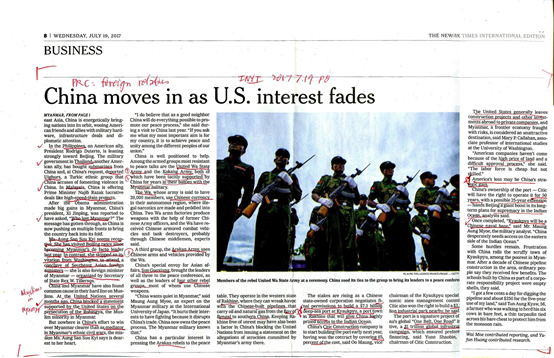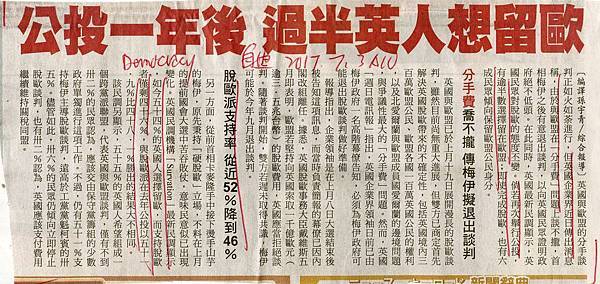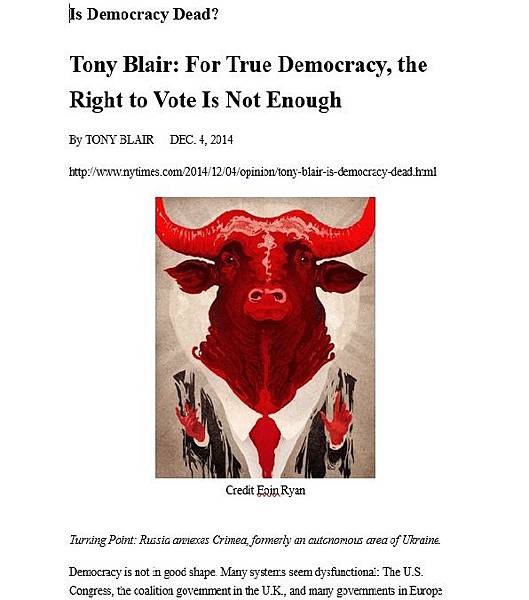緬甸轉向北京Myanmar attracts attention of Beijing”
Jane Perlez, The New York Times, July 19, 2017
https://www.nytimes.com/2017/07/19/world/asia/myanmar-china-us-diplomacy-trump.html
accessed July 24, 2017
● 緬甸曾在軍政府時期依附北京,但2011年被美國拉攏,並支持親西方翁山蘇姬主政。
● 可是最近翁山蘇姬靠向北京,甚至不去華府參加東南亞各國論壇而去北京。
● 緬甸轉向北京兩大原因:一、川普不像歐巴馬,對東南亞失去興趣。二、北京以「超軍事手段」(extra-military instrument)極力爭取東南亞國家。
● 轉向北京的國家有
- 美國盟友菲律賓。總統杜特蒂強力親中。
- 美國盟友泰國向北京購買潛艇,並應北京要求遣返逃至泰國的維吾爾人士。
- 馬來西亞接受中國高速鐵路計畫
● 北京吸引緬甸之手段包括
- 在聯合國阻止美國譴責緬甸迫害境內回教徒(Rohingya)
- 說服緬甸境內參與內戰之各族裔放下武器
- 建造73 億美元之皎漂(Kyaukpyu)港及附近32億美元之工業園區。皎漂港85%費用由北京負擔,也讓北京可獲得通印度洋之港口,甚至可能成為中國未來之海軍基地。
林中斌 2017.7.19


NAYPYIDAW, Myanmar — When Myanmar’s leader, Daw Aung San Suu Kyi, wanted to hold a peace con ference to end her country’s long-burning insurgencies, a senior Chinese diplomat went to work.
The official assembled scores of rebel leaders, many with longstanding connections to China, briefed them on the peace gathering and flew them on a chartered plane to Myanmar’s capital. There, after being introduced to a beaming Ms. Aung San Suu Kyi, they were wined and dined, and sang rowdy karaoke late into the night.
A cease-fire may still be a long way off, but the gesture neatly illustrates how Myanmar, a former military dictatorship that the United States worked hard to press toward democracy, is now depending on China to help solve its problems.
The pieces all fell into place for China: It wanted peace in Myanmar to protect its new energy investments, it had the leverage to press the rebels and it found an opening to do a favor for Myanmar to deliver peace.
China is now able to play its natural role in Myanmar in a more forceful way than ever before as the United States under the Trump administration steps back from more than six years of heavy engagement in Myanmar, including some tentative contacts with some of the rebels. The vacuum left by the United States makes China’s return all the easier.
When Myanmar began to adopt democratic reforms in 2011, the Obama administration quickly reciprocated, loosening sanctions as part of a broader effort to strengthen relationships with Southeast Asian nations as a bulwark against China’s rise.
As Myanmar’s relations with China cooled, the result of what many saw as heavy-handed intervention by Beijing, Barack Obama became, in 2012, the first American president to visit the country. He came again in 2014, promoting stronger trade and security relations, and counted Myanmar’s opening as a foreign policy coup.
But the United States did little to build on the new relationship, and now the tables have turned. As the Trump administration pays little attention, China is exercising strategic and economic interests that come from geographic proximity, using deep pockets for building billion-dollar infrastructure and activating ethnic ties with some of the rebel groups, all areas where the United States cannot compete.
“China wants to show: ‘We are doing our best at your behest,’” said Min Zin, executive director of the Institute for Strategy and Policy in Myanmar, who attended the peace gathering in May. “As the United States recedes, Aung San Suu Kyi is relying more and more on China in Myanmar and on the international stage.”
And not only Myanmar. Across Southeast Asia, China is energetically bringing nations into its orbit, wooing American friends and allies with military hardware, infrastructure deals and diplomatic attention.
In the Philippines, an American ally, President Rodrigo Duterte is leaning strongly toward Beijing. The military government in Thailand, another American ally, has bought submarines from China and, at China’s request, deported Uighurs, a Turkic ethnic group that China accuses of fomenting violence in China. In Malaysia, China is offering Prime Minister Najib Razak lucrative deals like high-speed train projects.
After the Obama administration made big gains in Myanmar, China’s president, Xi Jinping, was reported to have asked, “Who lost Myanmar?” The message has gotten through, as China is now pushing on multiple fronts to bring the country back into its fold.
Ms. Aung San Suu Kyi seems receptive. She has visited Beijing twice since becoming Myanmar’s de facto leader last year. In contrast, she skipped an invitation from Washington to attend a conclave of Southeast Asian foreign ministers — she is also foreign minister of Myanmar — organized by Secretary of State Rex W. Tillerson.
China and Myanmar have also found common cause in their hard line on Muslims. At the United Nations several months ago, China blocked a statement supported by the United States on the persecution of the Rohingya, the Muslim minority in Myanmar.
But nowhere is China’s effort to win over Myanmar clearer than as mediator in Myanmar’s ethnic civil wars, the mission Ms. Aung San Suu Kyi says is dearest to her heart.
“I do believe that as a good neighbor China will do everything possible to promote our peace process,” she said during a visit to China last year. “If you ask me what my most important aim is for my country, it is to achieve peace and unity among the different peoples of our union.”
China is well positioned to help. Among the armed groups most resistant to peace talks are the United Wa State Army and the Kokang Army, both of which have been tacitly supported by China for years in their battles with the Myanmar military.
The Wa, whose army is said to have 20,000 members, use Chinese currency in their autonomous region, where illegal narcotics are made and exported into China. Two Wa arms factories produce weapons with the help of former Chinese Army officers, and the Wa have received Chinese armored combat vehicles and tank destroyers, probably through Chinese middlemen, experts say.
A third group, the Arakan Army, uses Chinese arms and vehicles provided by the Wa.
China’s special envoy for Asian affairs, Sun Guoxiang, brought the leaders of all three to the peace conference, as well as the leaders of four other rebel groups, most of whom use Chinese weapons.
“China wants quiet in Myanmar,” said Maung Aung Myoe, an expert on the Myanmar military at the International University of Japan. “It hurts their interests to have fighting because it disrupts China’s trade. China now owns the peace process. The Myanmar military knows that.”
China has a particular interest in pressing the Arakan rebels to the peace table. They operate in the western state of Rakhine, where they can wreak havoc with the Chinese-built pipelines that carry oil and natural gas from the Bay of Bengal to southern China. Keeping Rakhine free of unrest may have also been a factor in China’s blocking the United Nations from issuing a statement on the allegations of atrocities committed by Myanmar’s army there.
The stakes are rising as a Chinese state-owned corporation negotiates final permissions to build a $7.3 billion deep-sea port at Kyaukpyu, a port town in Rakhine that will give China highly prized access to the Indian Ocean.
Citic Construction of China is to start building the port early next year, having won the contract by covering 85 percent of the cost, said Oo Maung, vice chairman of the Kyaukpyu special economic zone management committee. Citic also won the right to build a $3.2 billion industrial park nearby, he said.
The port is a signature project of China’s global “One Belt, One Road”initiative, a $1 trillion global infrastructure campaign, which ensured preferential financing, said Yuan Shaobin, vice chairman of Citic Construction.
The United States generally leaves construction projects and other investments abroad to private companies, and Myanmar, a frontier economy fraught with risks, is considered an unattractive destination, said Mary P. Callahan, associate professor of international studies at the University of Washington.
“American companies haven’t come because of the high price of land, and a difficult approval process,” she said. “The labor force is cheap but not skilled.”
America’s loss may be China’s strategic gain. China’s ownership of the port — Citic will have the right to operate it for 50 years, with a possible 25-year extension — hands Beijing a giant boost in its long-term plans for supremacy in the Indian Ocean, analysts said.
Once completed, “Kyaukpyu will be a Chinese naval base,” said Mr. Maung Aung Myoe, the military analyst. “China desperately needs access on the eastern side of the Indian Ocean.”
China is already building Indian Ocean ports in Pakistan and Sri Lanka, and it is seeking approval for one in Bangladesh.
Some hurdles remain. Frustration with China roils the scruffy town of Kyaukpyu, among the poorest in Myanmar. After a decade of Chinese pipeline construction in the area, ordinary people say they received few benefits. The schools built by China as part of a corporate responsibility project were empty shells, they said.
“I got a few cents a day for digging the pipeline and about $250 for the five-year use of my land,” said Tun Aung Kyaw, 56, a farmer who was walking to herd his six cows in bare feet, a thin tarpaulin tied across his bare chest to protect him from the monsoon rain.
Citic is aware of the hostility and is working with nongovernmental organizations in Kyaukpyu to avoid past mistakes, Mr. Yuan said. Citic will train Myanmar workers for 3,000 jobs for the park and the port, he said.
China also faces suspicions among Myanmar’s politicians, many of whom opposed a Chinese-financed dam planned at Myitsone, on the Irrawaddy River, to provide power to China. The previous government, yielding to public opposition, suspended the $3.6 billion project. Ms. Aung San Suu Kyi’s government has appointed a commission to decide the dam’s fate.
A confidant of hers and a member of her political party, Mi Khun Chan, said China viewed aiding the peace process as part of the cost of winning a green light for the dam.
For all the misgivings among her people about China, Ms. Aung San Suu Kyi seems impressed with Beijing’s power to assist in peace.
Her father, Aung San, the leader of Burma after World War II, dreamed of a united country. He almost got there, presiding over an agreement with ethnic leaders in 1947 for a federation of states. Six months later he was assassinated.
Ms. Aung San Suu Kyi wants to finish the job. “Our goal is the emergence of a democratic federal union based on democracy and federalism,” she said at the opening of the peace conference.
For the moment, she has China at her side.
















































